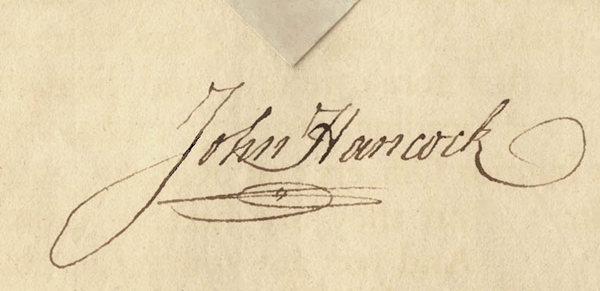
 |
|
The signature of Declaration of Independence signer John Hancock on an envelope. |
I was thinking about how difficult it has become to maintain good penmanship in the internet era.
When I was in grammar school, just about all our writing was cursive as opposed to block letters, and students would take pride in their signatures. There were required penmanship classes.
Now about the only time I write my name, with wildly fluctuating results, is when I'm signing a credit card receipt or check, and I write far fewer of those because of electronic payments.
I understand they face the same issue in China, where it's probably more dramatic because of the many strokes it can take to create a Chinese word.
At China Daily USA, we have the software that converts pinyin into Chinese characters, but users still do not have to make the strokes themselves; the keyboard does.
Four years ago, The Washington Post published this headline: "Cursive handwriting is disappearing from public schools."
Now, the United States is witnessing a movement to bring back penmanship, long the purview of persnickety teachers.
Alabama and Louisiana passed laws in 2016 mandating cursive proficiency in public schools, the latest of 14 states to require the connected, looping letters. And more are breaking out the figurative quill pen.
In Ohio, a bill would require school districts to teach cursive handwriting to students in kindergarten through fifth grade. The state's Legislative Service Commission said the bill aims "to ensure that students develop the ability to print letters and words legibly by third grade and to create readable documents using legible cursive handwriting by the end of fifth grade".
In Illinois, state Representative Chris Welch is sponsoring a measure that would ensure students receive at least one class in penmanship.
"I think we're losing a whole generation," Welch said. "You're having folks that are 18 and above that don't even know how to write in cursive."
In Delaware, state Representative Andria Bennett's bill would require cursive writing in public schools.
"You need to know cursive to sign checks and important documents," she said.
Last fall, the New York City public schools system, the US' largest, encouraged cursive's teaching.
Schools Chancellor Carmen Farina distributed a teacher handbook on the practice in September, The Associated Press reported. It cites research suggesting that fluent cursive helps students master spelling and sentence construction because they don't have to think as much about forming letters.
While some 78 percent of advanced placement and National Writing Project teachers surveyed in 2013 by the Pew Research Center in the US said digital tools such as the internet, social media and smartphones "encourage student creativity and personal expression", 68 percent said the devices make students more likely to take shortcuts and not put effort into their writing.
California is one of the 14 states that require cursive.
"Print writing yes, they need to learn their ABCs, but whether it's in block letters or cursive letters, I don't think it's absolutely necessary," Nisha Shah told ABC-TV's San Francisco affiliate.
The ABC Facebook page on the topic received more than 7,000 likes and 600 pro and con comments.
"It's (curvise) great for taking notes," Andria Shafer said.
"It's nice, but ultimately useless. Keyboard familiarity should be a requirement," De-Ante Glover said.
Teachers are divided too, with supporters saying it would be disappointing if a student could not read the original US Declaration of Independence in cursive.
Speaking of that 1776 document, the signature of one of its signers, John Hancock, was so spectacular that it became a part of the American vernacular: "I just need your John Hancock on the dotted line."
Still, we will continue to read all our text on digital devices and in print, in block letters. So the return of cursive could be somewhat sentimental.
It's the artistic beauty of cursive writing or calligraphy that inspires. And then of course there's old time's sake, with some parents wanting their children to learn it because they themselves had to, hence connecting the generations.
Contact the writer at williamhennelly@chinadailyusa.com.